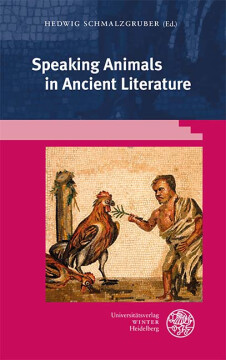
BUCH
Speaking Animals in Ancient Literature
Herausgeber: Schmalzgruber, Hedwig
Kalliope – Studien zur griechischen und lateinischen Poesie, Bd. 20
2020
Zusätzliche Informationen
Bibliografische Daten
Abstract
In the literature of Graeco-Roman antiquity, speaking animals are most prominent in fables, but in fact they are a genre-crossing phenomenon. Ancient traditions of animal speech continue to have an effect on European literature up to the present day and at the same time have parallels in other early civilizations like Ancient Egypt and Mesopotamia. In the 21 contributions of this interdisciplinary Conference volume, international researchers from the fields of Classical Philology, Ancient History, Egyptology, Ancient Oriental Studies, Theology and Jewish Studies explore animal speech in ancient texts from the very beginnings to late antiquity, including their reception. Contexts relating to literary, intellectual, cultural and social history are considered as well as concepts of animality and humanity, building a bridge to the more recently established Human-Animal Studies.
Inhaltsverzeichnis
| Zwischenüberschrift | Seite | Aktion | Preis |
|---|---|---|---|
| Cover | C | ||
| Titel | 3 | ||
| Impressum | 4 | ||
| Inhaltsverzeichnis | 7 | ||
| Vorwort | 11 | ||
| I Hedwig Schmalzgruber: Einführung | 13 | ||
| II Sprechende Tiere in der griechisch-römischen Antike | 21 | ||
| TIERREDE ALS LITERARISCHES MITTEL | 21 | ||
| Ines Silva: Is a Praying Fox a Humanised Animal or a Human in an Animal Body? A Cognitive Reading of Archilochus’ Fox and Eagle Epode (frr. 172–181W) | 23 | ||
| Ursula Gärtner: ‚Sua tamen sollertia‘ – ‚Reden von Tieren‘ bei Phaedrus | 55 | ||
| Sonia Pertsinidis: Articulate Animals in the Fables of Babrius | 81 | ||
| Hedwig Schmalzgruber: ‚Verbis certare volucres […] fecimus‘: Tierrede in Avians Fabeln | 103 | ||
| Stefan Feddern: Der allegorische und der fiktionale Charakter der Fabel und der Bibel im Urteil des Augustinus | 133 | ||
| Babette Pütz: Straight from the Horse’s Mouth: Speaking Animals in Aristophanes’ Comedy | 159 | ||
| Kenneth S. Rothwell Jr.: The Animal Voices of Greek Comic Choruses | 189 | ||
| Nina Mindt: Rede toter Tiere. Tierrede in antiken Epigrammen und im ‚Culex‘ | 207 | ||
| Sandro La Barbera: ‚At mea diffusas rapiuntur dicta per auras!‘ The Weight of a Mosquito’s Words in the Pseudo-Vergilian ‚Culex‘ | 253 | ||
| Niall W. Slater: Animal Speech and Animal Silence in the World of Apuleiusʼs ‚Golden Ass‘ | 285 | ||
| Morgane Cariou: Prosopopoeia in Didactic Poetry | 313 | ||
| Angela Pabst: Wenn die Tiere reden könnten – Vom ‚Logos‘-Gebrauch der Wesen ohne ‚logos‘ bei Plutarch | 333 | ||
| Émeline Marquis: Philosophy in the Farmyard: The Speaking Cock in Lucian’s ‚Gallus sive Somnium‘ | 359 | ||
| Susanna Fischer: Sprechende Schweine im Kontext der Saturnalien in der Spätantike: Symphosiusʼ ‚Aenigmata‘ und das ‚Testamentum porcelli‘ | 377 | ||
| TIERREDE ALS ÜBERNATÜRLICHES PHÄNOMEN | 399 | ||
| Marco Vespa: Presentifying the Divine in Ancient Greek Tales: Human Voices in Animal Bodies | 401 | ||
| Janet E. Spittler: How Do Animals Talk to Christians? Animals in the ‚Apocryphal Acts of the Apostles‘ and the ‚Physiologus‘ | 427 | ||
| IMITATION MENSCHLICHER REDE DURCH REALE TIERE | 445 | ||
| Kenneth F. Kitchell Jr.: Talking Birds and Sobbing Hyenas: Imitative Human Speech in Ancient Animals | 447 | ||
| III Jenseits der griechisch-römischen Antike: Sprechende Tiere in anderen Kulturen des Altertums | 477 | ||
| Angela McDonald: The Evolution of the Animal Voice in the Egyptian New Kingdom | 479 | ||
| Daniel Vorpahl: A Donkey That Speaks Is a Donkey No Less: Talking Animals in the Hebrew Bible and Its Early Jewish Reception | 509 | ||
| David Hodgkinson: Jaṭāyus, the King of the Vultures: A Comparative Study of the Function of Non-Human Speech in the ‚Rāmāyaṇa‘ and Homeric Tradition | 527 | ||
| IV Jenseits der griechisch-römischen Antike: Sprechende Tiere in einem „neu-altgriechischen“ Epos aus dem 19. Jahrhundert | 551 | ||
| Thomas Gärtner: Tierische Kampfansage. Die Paränesen der Mäusekämpfer in der ‚Anthropomyomachie‘ des Eduard Eyth (1840) vor dem Hintergrund der späthellenistischen ‚Batrachomyomachie‘ | 553 | ||
| V Verzeichnis der Beiträger*innen | 597 | ||
| VI Indices | 599 | ||
| Index locorum (in Auswahl) | 599 | ||
| Index animalium (in Auswahl) | 617 | ||
| Backcover | 620 |


 Publishing Platform by CloudPublish
Publishing Platform by CloudPublish